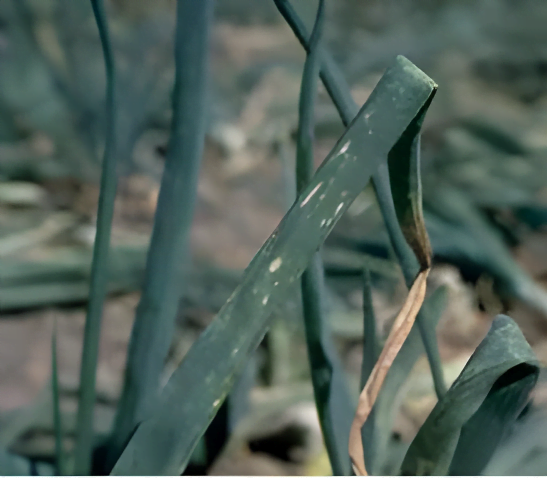Table of contents of the article
ToggleEarly blight is a disease that affects onion leaves, causing spots and leaf damage. This article from the “WORLD OF PLANTS” website provides an explanation of the symptoms of early blight on onion leaves and methods of prevention and control.
Causes of early blight on onion leaves
Disease name: Early blight on onion leaves
Scientific name: Botrytis squamosa
Type of disease: fungal
Disease family: Sclerotiniaceae
Early blight or Botrytis leaf blight occurs mainly on onion leaves, where the fungus forms hardened structures on infected tissue that can persist in the soil for months to years.
Symptoms of early blight on onion leaves
The initial symptoms of the disease appear in the form of white, oval-shaped spots on onion leaves, with a watery back and a pale green halo forming around the spots. As the severity of the infection increases, the spots on the leaves increase, causing the tips of the leaves to die, and the entire leaves may eventually die.

Development cycle of early blight on onion leaves
Mushroom spores are transmitted by the wind and infect onion leaves. In the presence of suitable weather conditions, the fungi germinate and produce enzymes that kill the leaf tissue, causing spots to appear on the leaves.
Suitable conditions for the spread of early blight on onion leaves
To infect leaves, the fungus requires temperatures ranging between 15-20 degrees Celsius, and humid conditions where leaf surfaces are wet from dew or rain for long periods of up to 20 hours or more for leaf spots to develop.

Losses resulting from the spread of early blight on onion leaves
If the infection is neglected, the disease spreads in the field, causing onion leaves to appear wilted and yellowish in color, leading to significant losses in the quantity and quality of the crop.
Controlling early blight on onion leaves
- Organic control: Avoid overhead spraying and use drip irrigation. Plant residues and harmful weeds must be eliminated in the field and fertilization should be stopped when the first symptoms appear.
- Chemical control: Fumigating the soil helps reduce the severity of the infection or using fungicides containing chlorthalonil or iprodione.
Preventive measures for early blight on onion leaves
- Leave enough space between each plant to enhance air circulation in the field.
- Avoid planting onions in a field that has been infected for 3 years.
- Use disease-free seedlings.
- Use a good irrigation and drainage system to reduce soil moisture.
In conclusion, we would like to note that we, at the world of plants website, offer you all the necessary services in the world of plants, we provide all farmers and those interested in plants with three main services::-
- Artificial intelligence consulting service to help you identify diseases that affect plants and how to deal with them.
- Blog about plants, plant diseases and care of various crops ... You are currently browsing one of her articles right now.
- An application that provides agricultural consultations to clients, as well as a service for imaging diseases and knowing their treatment for free – Click to download the Android version from Google Play Store، Click to download the IOS version from the Apple App Store.
- Sources:
Development of early blight symptoms
Botrytis Leaf Blight – UNIVERSITY OF CALIFORNIA AGRICULTURE AND NATURAL RESOURCES





1 Comment
مقالة جيدة تشرح الموضوع بشكل مفصل